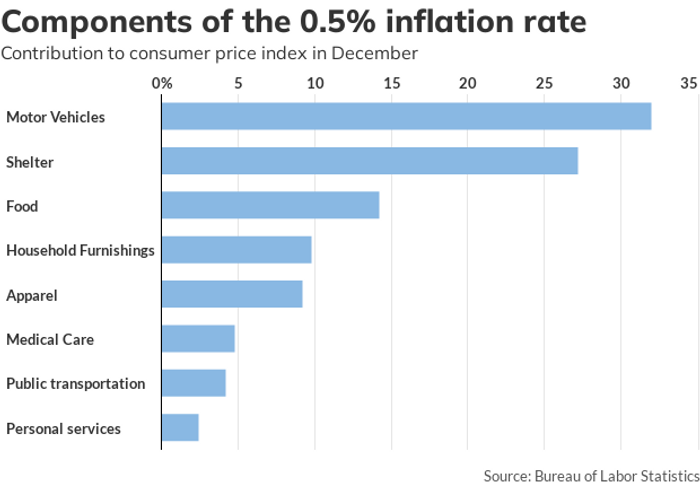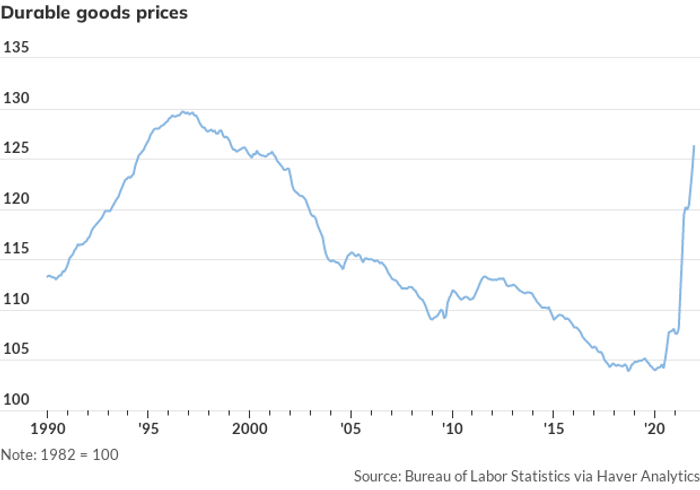After decades in hibernation, inflation woke up in 2021 in a terrible rage. The consumer price index increased 7% in 2021, the fastest pace in 39 years.
The inflation story is bound to be a big one in 2022, as well, as the Federal Reserve tightens monetary policy, stock markets SPX, +0.28% DJIA, +0.11% tremble and a crucial midterm election approaches.
Early in the year, the price increases mostly reflected idiosyncratic supply-chain problems stemming from the COVID-19 pandemic, but as 2021 wore on inflation spread to almost every corner of the economy.
Still, prices are increasing fastest for goods, such as food, vehicles and furniture. Inflation in services remained moderate except for the most important one: shelter.
Breaking news: Consumer prices rise 0.5% in December and push inflation rate to nearly 40-year high of 7%
Nearly everything may be more expensive, but some prices are going up faster than others, and some prices mean more to us than others, because they are a bigger part of our budget. (It goes without saying that every family is different; these numbers are averages for urban American families.)
In this analysis, I’m examining where the inflation came from, and where it didn’t.

The increase in car and truck prices accounted for about one-third of the 0.5% gain in the CPI in December. Hair cuts, appliances, clothing and airfares also made a big impact on the inflation rate.
MarketWatch
Four items in the family budget
The bulk of the gains last year were in four big items in the typical family’s budget: energy, motor vehicles, shelter and food. Those four items represent about 61% of consumer purchases but account for 79% of the inflation we’ve experienced over the past 12 months.
Energy prices were the biggest contributor to inflation for the year. Although energy takes less than 8% of the typical family budget, it accounted for about 26% of inflation. The good news: Global energy supply and demand seem to be getting back into balance. Energy prices actually fell 1.1% in December.
Motor vehicles accounted for about 21% of the inflation in 2021 and 32% of it in December, even though they, too, represent only about 8% of consumer purchases. Automobile makers are still struggling to get parts, and sales of new cars slumped in December as inventories remained near record lows. The lack of supply pushed up the price of new vehicles by 1.3% and used cars by 3.5% in December.

Prices of durable goods, such as trucks and appliances, have soared since the pandemic after falling steadily for decades.
MarketWatch
Sea change in durables
But it’s not just new and used vehicles that have gotten more expensive. The sea change has been in the price of durable goods, which are defined as physical commodities designed to last three years or longer. Think of trucks, washing machines, TVs and furniture.
Because consumers flush with emergency cash payments from the government were deprived of access to many of their favorite services (such as travel and recreation), demand soared for goods, especially those that make their homes more inviting, their commutes safer and their lives more fun. Unfortunately, at the same time, the pandemic crimped supplies of finished goods and vital parts. You can guess what happened: Prices of durable goods skyrocketed.
In the past year, durable-goods prices are up 16.8%, the largest increase since American manufacturers went on a war footing in 1942. To show how extraordinary the price increases are, you should note that prices of durables fell nearly 20% between 1996 and the start of the pandemic in March 2020.
The low inflation of the 2000s and 2010s was built on a foundation of steady deflation in durable-goods prices, largely because of globalization and more productive manufacturing. But that was then. Durable goods, which represent about 12% of consumer spending, accounted for 26% of the inflation in 2021 and 40% of the inflation reflected in the December CPI report.
In December, prices of household furnishings, which include furniture, appliances, blinds, dishes and other items for the house, rose 1.3%, contributing nearly 10% of December’s gains. For the year, furnishings rose 7.4%, the fastest growth on record.
Another clear consequence of the disruption in global trade was the 5.8% increase in apparel prices in 2021, the largest since 1980. Clothing prices had fallen 8% between 1994 and 2020 as production moved to low-cost countries. Prices jumped 1.7% in December, accounting for about one-tenth of December’s overall retail price rise.
All told, prices of commodities (including both durables and nondurable goods such as food, gasoline and clothing) rose 12.3% over the past year. They contributed about two-thirds of inflation but accounted for just 39% of spending.
Services, which represent about 61% of consumer purchases, are up a much smaller 4%, contributing just over one-third of inflation in 2021. That’s twice the Federal Reserve’s inflation target of 2%.
Shelter and food
Shelter is by far the biggest part of services spending, accounting for about one-third of the total consumer budget. Homeownership costs and rents (together the government calls them “rent of shelter”) have begun accelerating, a delayed reaction to the historic gains in home prices since the pandemic began.
In 2021, the price of rent of shelter rose 4.2%, contributing about one-fifth of the inflation we’ve seen. Over the past three months, however, shelter prices are up at a 5.4% annual rate, a major concern for the Federal Reserve. Shelter prices are very sticky and carry a big weight in the CPI.
Food prices, by contrast, are very flexible. Because consumers buy food all the time, they notice when prices go up. Grocery prices rose 6.5% in 2021 and have soared at a 10.8% pace over the past three months.
Prices for food purchased for consumption away from home have risen 6% in the past 12 months, with restaurant and fast-food prices rising at the fastest pace on record. Everyone knows food costs a lot more than it used to.
Food represents about 14% of consumer purchases, split almost evenly between food purchased for home consumption and food consumed away from home. Food accounted for about 13% of inflation in 2021.
Where inflation isn’t
The inflation news isn’t universally bad. Several items that people used to worry a lot about in the past have been rather tame recently.

Higher-education tuition, having raced upward at a rate of 6.7% a year in the 2000s and 3.4% in the 2010s, rose just 1.8% in 2021.
Getty Images
Healthcare, for instance, was a major preoccupation in the decade before Obamacare was enacted in 2010. But over the past year, despite a terrible health emergency, medical-care prices are up just 2.1%. Prescription-drug prices are flat, and health-insurance prices are down 1.2% due to increased government subsidies. However, medical-care prices have been accelerating from a low level. In the past three months, they’re up at a 4.1% rate.
College tuition, which rose at a 6.7% annual rate in the 2000s and 3.4% in the 2010s, increased just 1.8% in 2021.
Rex Nutting is a columnist for MarketWatch and has been writing about the economy for 25 years.









